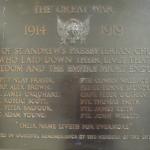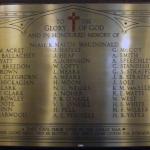Circumstances of Casualty: This soldier while in a dugout about 30 yards left of a trench, known as “Tenth Street” and about 30 yards East of “Death Valley” in the vicinity of Courcelette, was instantly killed by an enemy shell which hit the dugout.
BX November 8, 1916
Corporal Alexander Brown
Although the casualty list has been very light within the past few days, a few Brantford men are still being reported killed or wounded. Today Mr. William Brown of 108 Chestnut Avenue received the word that his son, Corporal Alexander Finletter Brown, of the signalling section of the 84th Battalion, had been killed in action on October 26. Corp. Brown, who was born in Scotland, lived in Brantford for over five years, and was extremely well known here. He was in his 20th year. The dead hero’s father is a sergeant in the 215th Battalion, and his sister’s husband, Pte. Boot, is at present in an English hospital. One other brother survives him.
BX November 13, 1916
In Memoriam for Corporal Alexander Brown – A Special Service Held at St. Andrew’s Church Last Evening
Last night a memorial service for Corporal Alexander Finletter Brown was held at St. Andrews Church. Corp. Brown was officially reported killed in action on October 25. He enlisted in June, 1915, with the 25th Dragoons and was later transferred to the 84th Battalion, where he joined the signalling corps under Captain Creighton. He proved so willing, so capable and efficient that it was only his youthfulness which prevented him from being made sergeant. He was 19 years of age last July, and at the time of enlistment was employed as a machinist at the Waterous Engine works.
A large number of his friends were in attendance last night to do honor to his memory. Corp. Brown was of a bright sunny disposition, unselfish and kind, and made friends wherever he went. He was a member of St. Andrew’s Church, of the Sunday school and of the Young Peoples society.
Reverend J.W. Gordon preached from the text Romans xiv; 6: “Whether we live therefore or die we are the Lord’s,” and paid tribute to the Christian beauty of the life of Corp. Brown. The choir sang “Crossing the Bar” and the quartet sang “The Home Land.” The pulpit and the pew of Corporal Brown were draped in black silk with flags. There remain to mourn his loss his father Sergeant Brown of the 215th Battalion, his mother, 105 Chestnut Avenue; a brother, George, at home and two sisters, Mrs. Brown of Parry Sound [?].
BX September 27, 1920
Memorial Window to Heroic Fallen Unveiled at Brant Avenue Church – Chancellor Bowles of Victoria College Officiated at Official Recognition of Nine Members of the Church Who Gave Their Lives in the Great War – A Ceremony Pregnant With Meaning
In dedication to the nine men of Brant Avenue Methodist Church who gave their lives in the Great War, a memorial window was unveiled in that church at the morning services yesterday. Rev. Chancellor Bowles of Victoria College, Toronto, gave the message of consolation to the friends of the soldiers whose memory he extolled and Major A.E. Lavelle, D.D., and Major E. Sweet both in uniform, unveiled the window. The congregation filled the church to the last pew and each one could not fail to receive, from the simple and impressive ceremony, a strong, new motive for keeping alive what Chancellor Bowles called a great and glorious memory.”
Deeply impressive and heart soothing was the whole ceremony. Rev. J.D. Fitzpatrick, the pastor of the church, was in charge and the choir gave special music, including solos by Miss Reba Force and Miss Margaret Stephen, the latter of Toronto. The military significance of the event was emphasized by the number of men attending in uniform. Besides Major Sweet and Major Lavell, places of prominence were given to Col. M.A. Colquhoun, D.S.O., C.M.G., Lieut.-Col. M.E.B. Cutcliffe, Major Jordan, Lieut. K.V. Bunnell, Lieut. Donald Waterous, Lieut. Charles Sheppard, Capt. (Dr.) Leonard Coates, Capt. Dufferin Slemin, Lieut. Fred Pinnell, Capt. Morley Verity and Sergt. James Hitchon, Nursing Sister, Captain Annie Hartley, was also present.
The Decorations
A special committee had spent much time in making the church beautiful, draping the chancel in flags and wreathing maple leaves over the window and around the memorial tablets formerly erected. Bouquets of mauve and white and pink and white asters were placed on the sill of the window.
The Sermon
Following the solemn prayer by Rev. J.D. Fitzpatrick and the choir offerings, Rev. Chancellor Bowles preached a most impressive sermon.
The dedication of the memorial, said Dr. Bowles, was promoted by instincts of love and gratitude and loyalty that sought to keep in recollection the names of those who were gone, their voices, their faces and the deeds they had done. Thoughts of them were like a benediction after prayer, for memories such as theirs soothed and elevated and enriched men’s lives and kept them in touch with the living past. Many memorials were being erected, he said, from simple tablets to costly community halls, churches and arches; yet the outward form mattered little, what counted was the appreciation and admiration of those who raised them. Every memorial was erected “Lest we forget.”
It was not likely this generation would ever see such another war, it was the grimmest and most awful thing men had ever faced; they had been overwhelmed by its terrible destruction and death. This ceremony was held to lead others to know its meanings and learn its lesson well – “Lest we forget.” Drawing his bearers to think of the many elements that entered into the cause of the war, the struggle, said the Chancellor, had written its own inner meaning. Humanity could live in safety on this earth only as a spiritual and moral force; there must be a right relationship among the nations; men had come to feel the sense of the ultimate value of what was right and what was fair. “We know what conceptions and ideals moved our boys,” Dr. Bowles went on. “They had the sense of human value. Most of them were scarcely young men, they were only boys. Life had no problems for them yet; the iron had not entered into their souls. Now they make one small portion of those who like in Flanders’ Fields. They had not lived their lives as some listening to me have almost done, they poured out the wine of youth, life’s passions; nor” he said, “will you cease to think of them as young and fair. From the many letters I read written by Victoria College students, I was struck by the cheer and the steadfastness to duty they expressed. From one I have here, written to the soldier’s mother, before the great struggle of August 8, he concluded, ‘a great triumph will take place and I shall have a part in it.’ Remember”, said the Chancellor in closing “that was the spirit that actuated them through it all.”
The Unveiling
Major Lavell and Major Sweet conducted the unveiling ceremonies, the former giving a brief address and the latter reading the names and drawing aside the Union Jack which covered the memorial window.
In beginning his remarks Major Lavell referred to Major T. Harry Jones, who had so much to do with the memorial window, but who had not lived to see the completion of the work. He said that out of the many thoughts that crowded in upon his mind there were but three he had time to express. The first was the sorrow that those present must feel who were nearest and dearest to the men whose names were on the memorial. This sorrow and perplexity at death was as old as the race. To this sorrow he had little to give but sympathy. Possibly if they would find the secret of Calvary and see our Lord’s death as victory and not defeat, they would have light and much comfort. The second was that the front line areas made a school the like of which existed nowhere else. It tested, disciplined and changed every man. They learned to know real values, what was worth retaining and what might be well given up. The third was that these brave young men having passed through this school that most of those present had not passed through, and therefore knew not, willingly faced death and died doing their duty, which to them was far preferable to mere living. Could their loved ones here not have faith in their faith and even in their sorrow and ignorance believe in the light seen by those who had fearlessly walked through the valley of the shadow?
Major Lavell quoted from Sir Arthur Currie’s message to the Canadian soldiers, delivered on March 27, 1918. How true, he said, his finals words had become and how appropriately they had been chosen for the inscription on the window: “You will not die, but will step into immortality.”
Impressively and clearly Major Sweet read the roll of those whose names were inscribed on the tablet:
Harold Staples Brewster
Alexander Finletter Brown
Hugh Dalton Livingston
Lawrence Wilmot Livingston
Joseph Howard Pinnell
Earl Pettit Pitcher
Harold Brant Preston
Frederick Stanley Schell
Egerton Vaughan
As the window was revealed and the names were called, the notes of the “Last Post” were sounded by Sergeant Beech of the Dufferin Rifles.
The committee of arrangements consisted of Mrs. R.S. Schell, Mrs. W.C. Livingston, Mrs. J.J. Vaughan, Messrs. W.S. Brewster, T.H. Preston, E. Sweet and C.S. Slemin.




